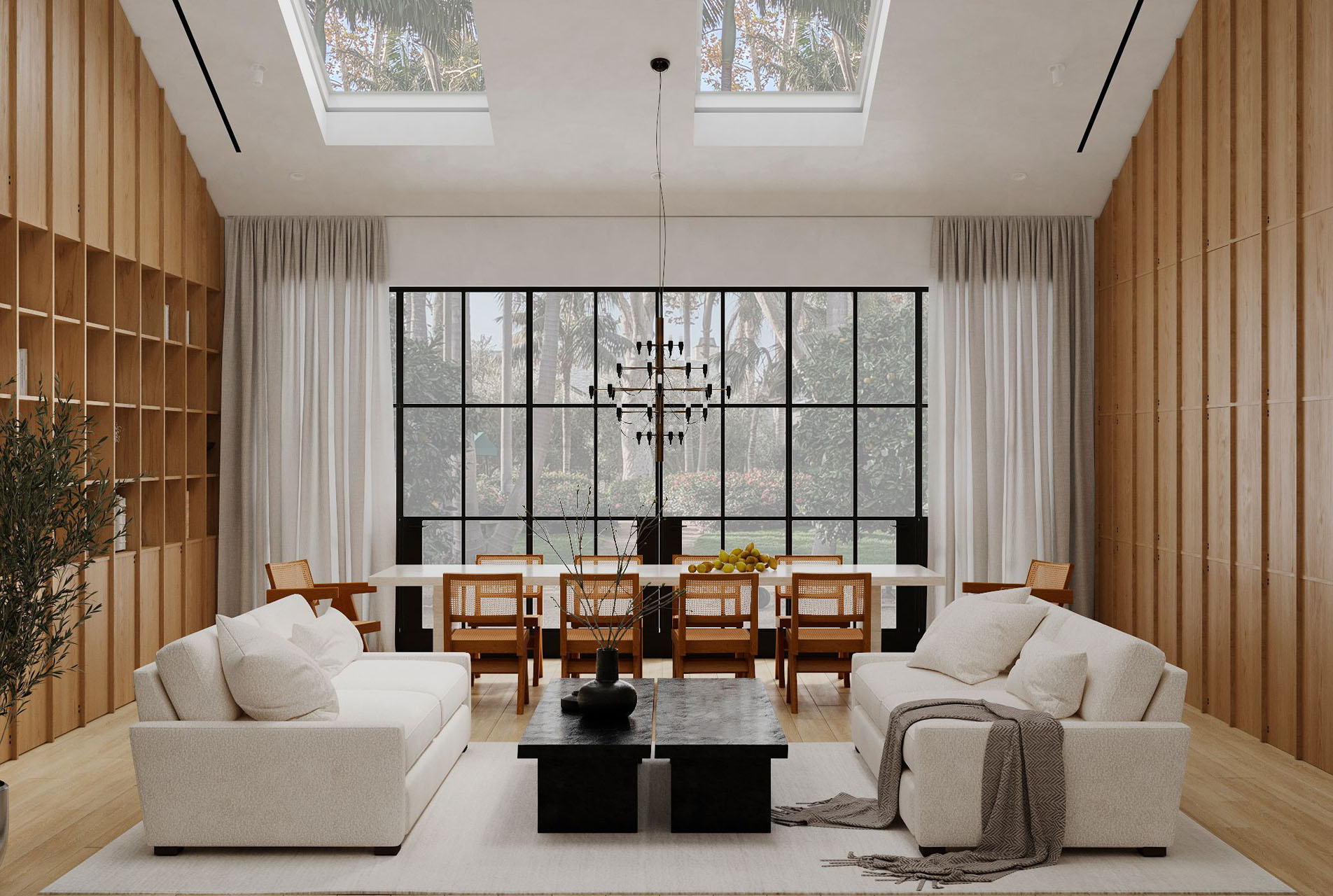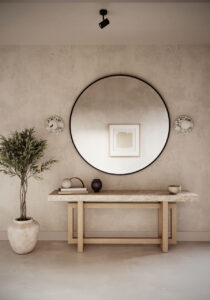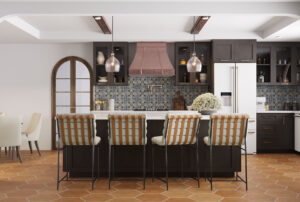Organic modern interior design isn’t just a trend; it’s a nod to both the past and future of home aesthetics. Picture a scene where sleek, contemporary lines meet earthy textures and natural elements, creating spaces that are as calming as they are captivating. This style has roots in the early 20th century, evolving from the Arts and Crafts movement which emphasized handcrafted detail and natural materials. Today, it stands at the intersection of minimalism and warmth, offering a fresh take on living spaces that feel both open and inviting. Whether you’re revamping your city apartment or giving your country house an update, understanding organic modern principles can transform your space into a serene sanctuary without sacrificing sophistication.
Understanding Organic Modern Design
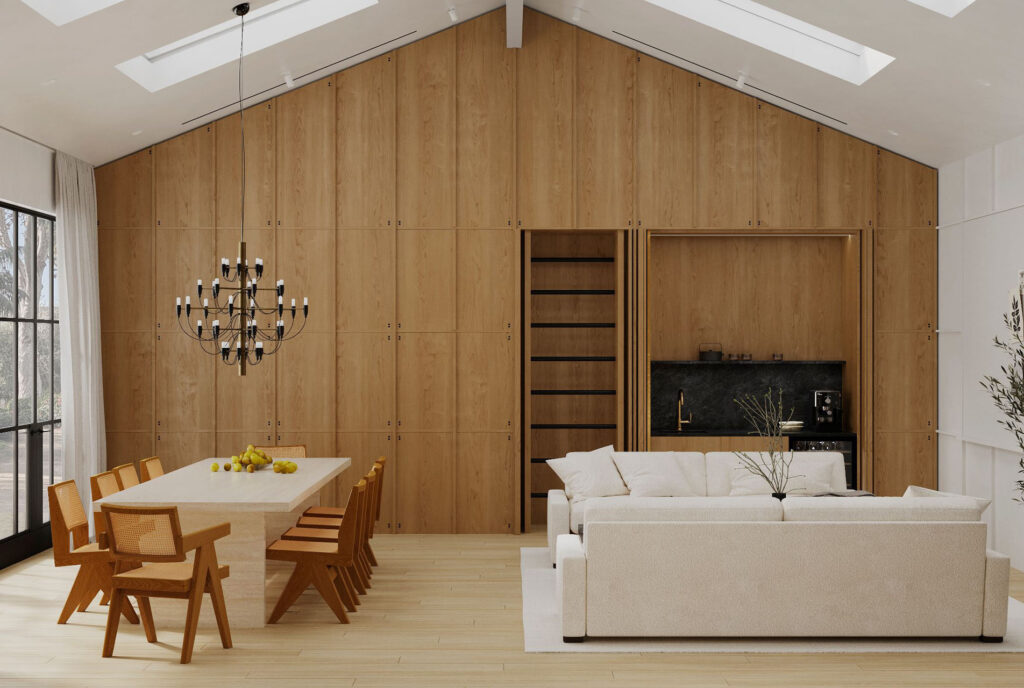
Key Characteristics
Organic modern interior design shines through its emphasis on natural light and open spaces. Large windows are common. They let in sunlight, making rooms feel airy and spacious. This design style values the connection with the outdoors.
Sustainable, organic materials play a big role too. Think bamboo floors or wool rugs. These choices are not just good for the planet but add a touch of nature to your home.
The approach is minimalist yet functional. Every piece has a purpose, avoiding clutter. This simplicity brings calmness to any space.
Elements of Style
This design style marries modern lines with organic forms beautifully. Furniture might have clean lines but be made of natural wood. It’s all about balance.
There’s also a fascinating play between textures in organic modern homes.
- Soft fabrics might pair with rough stone.
- Shiny metals could complement matte woods.
Neutral color palettes dominate this style, creating serene environments. Occasionally, bold accents break the monotony, adding life to rooms without overwhelming them.
Achieving a Lived-In Feel
Incorporating handcrafted items is key here. These pieces tell stories and add character to your home. They make spaces feel more personal and lived-in.
Layering textures adds depth and warmth too. A knitted throw on a leather sofa or rattan baskets atop sleek shelves can do wonders.
Selecting furniture that offers comfort and durability is crucial as well. It’s not just about looks; it’s about creating a cozy haven you’ll love coming back to every day.
By focusing on these aspects—natural light, sustainable materials, minimalist designs, and thoughtful details—you can create an inviting space that embodies organic modern interior design perfectly.
Essential Components
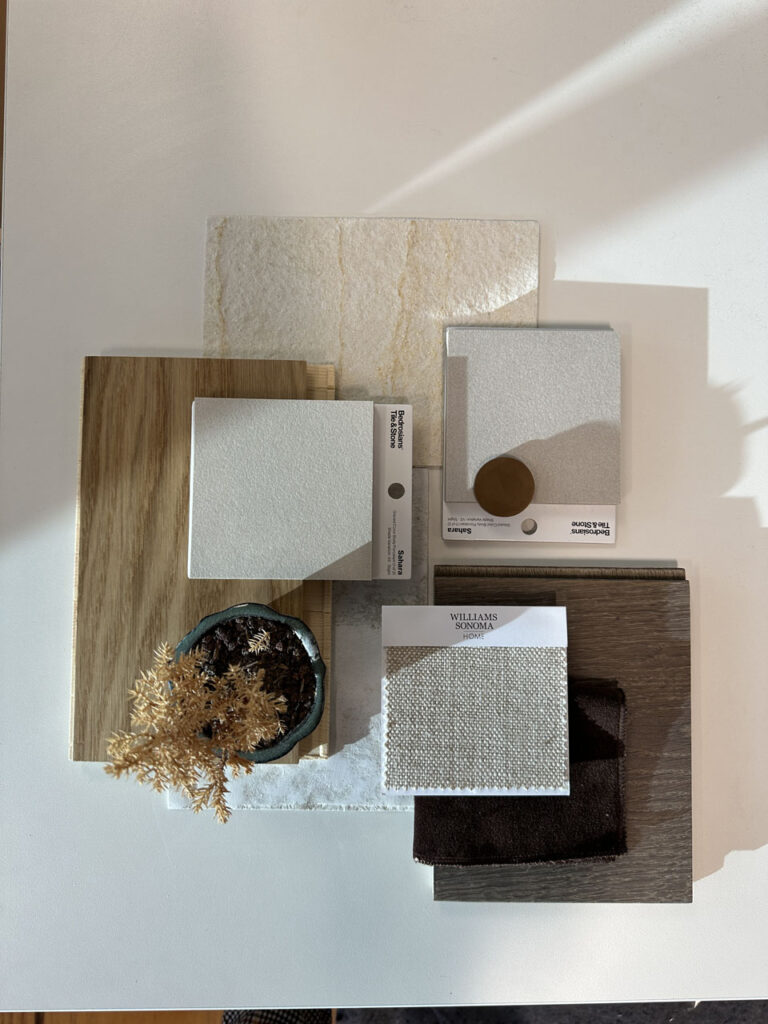
Utilizing Earthy Textures
Organic modern interior design thrives on the warmth and authenticity of earthy textures. Natural wood brings a sturdy yet inviting element to furniture and decor. Its grains tell stories of nature’s beauty.
Stone, in its raw or polished form, adds a touch of rugged elegance. It’s perfect for walls or countertops. Fibers like wool, cotton, and linen introduce softness into spaces. They make couches and beds feel more welcoming.
Choosing matte finishes over glossy ones is crucial here. Matte surfaces reflect less light, which enhances the natural look of materials.
Incorporating Greenery
Indoor plants are not just decorations; they’re life enhancers in organic modern spaces. They improve air quality while adding a splash of color against neutral tones.
Selecting planters that blend with your room’s style is key. A wooden planter might complement a minimalist space well, whereas ceramic ones could add texture to sleek interiors.
Opt for low-maintenance greenery if you’re not a gardening expert. Snake plants and succulents are great choices as they require little attention but provide maximum impact.
Playing With Shapes
The interplay between geometric shapes and organic forms creates visual interest in any room designed with an organic modern theme. Rounded furniture pieces can soften the hard lines typically found in modern design. Think about incorporating circular tables or curved sofas into your living area. Asymmetrical arrangements keep the eye moving around the space, making it feel dynamic yet cohesive. A bookshelf with irregularly spaced shelves or an off-center art piece can achieve this effect beautifully.
By understanding these essential components—earthy textures, greenery incorporation, and playful shapes—you can create spaces that embody both modern cleanliness and natural warmth. This approach ensures rooms aren’t just stylish but also deeply comforting places to live in.
Designing Key Spaces
Dining Room Essentials

Creating an organic modern interior design in your dining room starts with choosing the right pieces. A solid wood dining table serves as the heart of this space. It’s not just a place to eat; it’s a statement piece that defines the room’s character. Look for tables with clean lines and natural finishes.
Comfort is key when selecting seating options. Choose chairs that offer both style and comfort, allowing guests to linger over meals without discomfort. Opt for materials like leather or soft fabrics in earthy tones.
Lighting plays a major role too. Minimalistic lighting fixtures, such as pendant lights made from organic materials, can add warmth while making a bold statement. They should provide enough light but also fit into the minimalist decor theme.
Bedroom Aesthetics
The bedroom is your sanctuary, so keeping it clutter-free is crucial for relaxation. Use under-bed storage or built-in closets to hide away belongings and maintain clean lines throughout the space.
Bedding should invite you in with its comfort and texture. Choose soft, layered bedding made from natural fabrics like cotton or linen in soothing colors. This adds depth while promoting restful sleep.
Ambient lighting sets the mood for relaxation before bed. Install dimmer switches or use lamps with warm-toned bulbs to create a serene atmosphere that encourages unwinding after long days.
Bathroom Styling
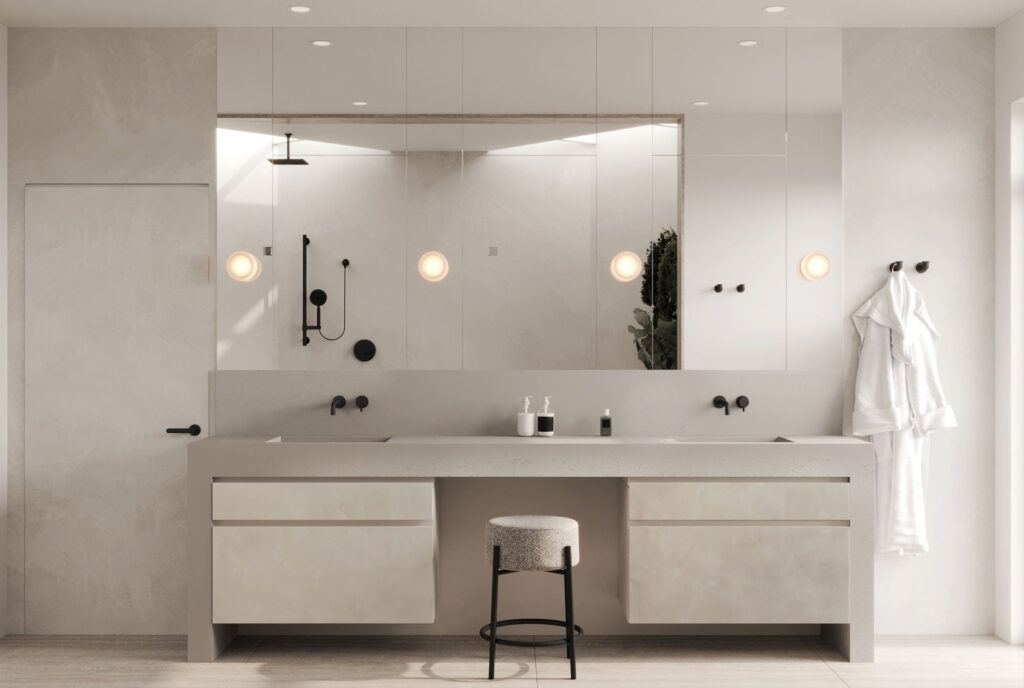
Incorporating elements of nature transforms bathrooms into spa-like retreats within your home. Using natural stone or tiles on floors and walls adds texture and brings an element of the outdoors inside. When space allows, installing a freestanding tub can act as both functional art pieces adding elegance to any bathroom setup. Keep decor minimalistic; choose items that are both practical and aesthetically pleasing—a few well-placed plants or bamboo accessories can enhance rather than clutter.
Furniture Selection
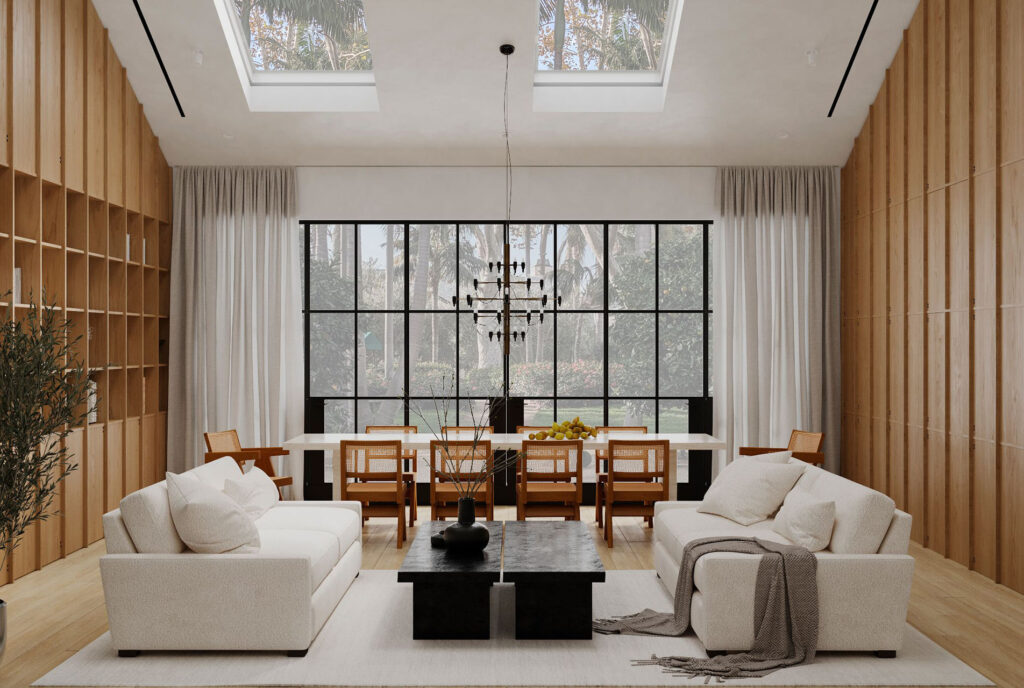
Organic Modern Pieces
Selecting the right furniture is key in organic modern interior design. This style focuses on clean lines and natural materials. Think of a sleek wooden table or soft, linen sofas. These pieces should blend seamlessly with your space, enhancing its beauty without taking over.
Decorative items are also important but choose wisely. A few well-placed vases or sculptures can add personality to a room. They should have simple designs that echo the natural world, maybe an abstract wood carving or a pottery piece inspired by ocean waves.
Art plays a big role too. Look for pieces that reflect nature, whether through literal landscapes or abstract shapes and colors that remind you of the outdoors. This approach keeps the room feeling grounded and connected to the earth.
Sourcing Unique Items
To truly capture the essence of organic modern design, it’s essential to source unique items. Local artisans and craft fairs are treasure troves for one-of-a-kind finds. A handmade wooden bench or a custom ceramic lamp can become focal points in your rooms, adding depth and authenticity.
Handmade rugs and pottery not only enhance the aesthetic but also bring stories into your home. Each piece carries traces of its maker’s hands, adding soul to your spaces.
Vintage finds play an important role too; they offer timeless appeal that new items can’t match. A mid-century modern chair or an antique wooden chest adds character while staying true to the clean lines crucial in organic modern design.
Finding Inspiration in Los Angeles
Los Angeles is full of creativity and inspiration, and as a local interior designer, I love sharing the places that fuel my passion. When RentCafe.com asked me to contribute my favorite art-focused spots around the city, I was thrilled to highlight a few that truly stand out. For fellow art lovers, I suggested exploring the Culver City Arts District – it’s full of contemporary galleries, and Apparatus is one of my personal favorites for its bold, sculptural lighting and interiors. I also recommended the Getty Center, not just for its incredible art collection, but for the stunning architecture and panoramic views. You can check out all my tips, along with suggestions from other locals, in the full article on the best things to do in Los Angeles for art lovers.
Color and Texture

Pretty Neutrals
Organic modern interior design loves neutrals. Whites, beiges, and grays form the calm base palette. These colors make spaces feel open and serene.
Layering shades adds depth. Imagine a beige sofa against a light gray wall. It’s subtle but effective. Textures play a big role too. A wool throw or a linen pillow can transform the look.
Keeping things cohesive is key. Mix shades carefully to avoid clashes. Subtle variations in color keep the eye moving without overwhelming it.
Pops of Color
While neutrals dominate, vibrant hues have their place in organic modern design too.
Accessories are perfect for this. Think bright cushions or bold art pieces. They add life to neutral settings without overpowering them.
Stick to one accent color for simplicity’s sake. This maintains an uncluttered look while providing contrast and interest. Plants are fantastic for adding natural color too.
Adding Wall Texture
Texture on walls introduces dimensionality into organic modern spaces. Textured wallpapers or plasters create interest without cluttering up space. Exposed brick or concrete adds an industrial touch that complements organic elements well.
Balancing textured walls with smooth surfaces elsewhere is crucial. For instance, pair a rough plaster wall with sleek wooden furniture from the previous section on Furniture Selection.
This balance between rough and smooth enhances both texture and depth within your space.
Maximizing Natural Elements
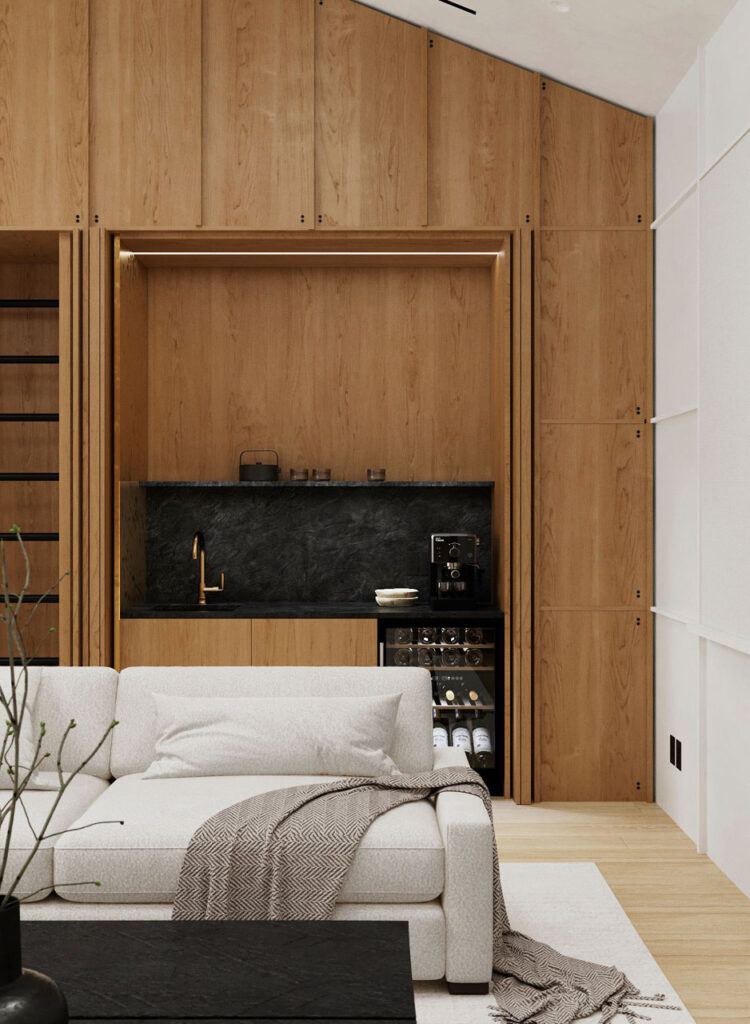
Wood for Walls and Ceilings
Wood brings warmth and life to any space. Cladding walls or ceilings with wood panels can transform a room. It adds a cozy, inviting feel. For an eco-friendly touch, selecting reclaimed wood is wise. It’s not only sustainable but also adds character with its unique marks and textures.
Staining the wood in light finishes keeps spaces looking bright and airy. This approach maintains the essence of organic modern interior design. It blends the natural beauty of wood with a modern aesthetic.
Stone Statements
Stone introduces an element of rugged elegance to interiors. Incorporating stone accent walls or countertops can make a powerful statement. They add texture and depth to rooms without overwhelming them.
For bathrooms, using pebbles or river rocks creates a spa-like atmosphere. It’s like bringing a piece of nature indoors for daily enjoyment. Select stones that have unique veining or patterns for added visual interest.
Maximizing Views
Designing your layout around outdoor scenery enhances the connection to nature—a core aspect of organic modern design. Installing large windows or glass doors helps blur the boundaries between inside and outside spaces. This not only maximizes views but also floods rooms with natural light.
Keeping window treatments minimal ensures that nothing obstructs these stunning views. This strategy makes every glance outwards feel like gazing at artwork curated by nature itself.
Decorative Accents
Integrating Ceramics
Ceramic pieces add a unique touch to organic modern interior design. Displaying ceramic vases or sculptures can introduce artful elements into your space. These aren’t just any decorations; they’re statements of craftsmanship and natural beauty.
Handmade tiles bring character, especially when used as backsplashes. Each piece tells a story, making your kitchen or bathroom stand out. Opt for glazed ceramics in muted tones to complement neutral color schemes. This choice ensures that the décor enhances rather than overwhelms the room’s ambiance.
Weathered Elements
Adding patina finishes on metal fixtures introduces depth to interiors. It’s like each item has its own history, contributing to the overall narrative of your home. Designers often recommend this technique for adding soul to modern spaces.
Incorporate distressed wood furniture subtly within rooms. A side table here, a bookshelf there – these pieces invite warmth and texture without dominating the theme. Use weathered leather accents sparingly for an extra layer of richness and comfort.
Cozy Accents
Soft, knitted blankets thrown over seating areas create inviting spots throughout your home. They beckon you to curl up with a good book or enjoy quiet moments with loved ones.
Place plush rugs underfoot in living spaces for added warmth and texture. These rugs make every step comfortable while also tying together various elements in the room. Select pillows in different textures but cohesive colors to complete the look. Mixing materials adds visual interest, while sticking to a unified palette keeps everything harmonious.
Bespoke and Timeless Storage Boxes
When designing your home, every detail matters, including how you store and display your treasured possessions. Bespoke jewelry boxes are the perfect blend of functionality and elegance, offering a sophisticated way to organize and protect your precious jewelry from Cartier or Grandiani. Crafted with high-quality materials and thoughtful design, these custom boxes complement the aesthetics of any space while ensuring your valuable diamonds rings or necklaces are safely stored.
Incorporating stylish storage solutions is essential for maintaining an organized and visually appealing home. Decorative storage boxes made from materials like wicker, wood, or fabric can serve dual purposes, keeping clutter out of sight while enhancing the room’s aesthetic. Opt for neutral or earth-toned designs to align with an organic modern theme.
Maintaining the Aesthetic
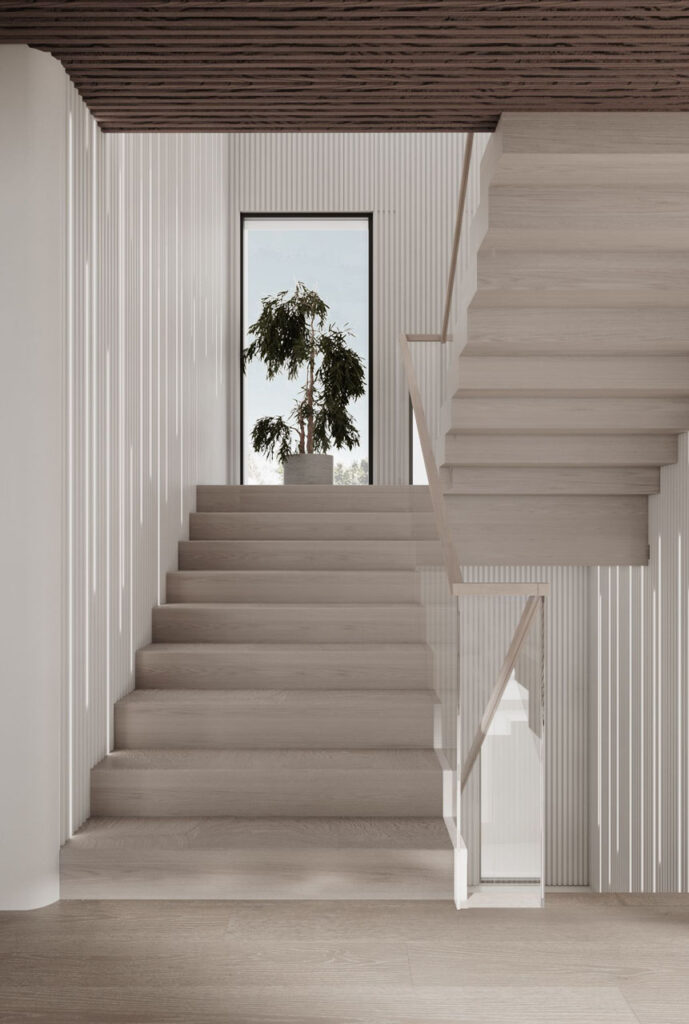
Minimizing Clutter
To embrace organic modern interior design, minimizing clutter is key. Built-in storage solutions can be a game-changer. They keep items out of sight, creating a clean look. Consider wall units or under-bed drawers for extra space.
Keeping surfaces mostly clear enhances the serene vibe organic modern style aims for. Display only intentional decor that speaks to you or serves a purpose. This approach ensures every item adds value to your space, rather than just filling it.
Regular decluttering sessions are vital in maintaining this aesthetic. Set aside time each week to review what’s around you. Ask yourself if each item still serves its purpose or brings joy. If not, it might be time to let go.
Clean Lines
Choosing furniture with streamlined silhouettes is another pillar of organic modern interior design. Look for pieces that boast simple shapes and avoid anything too ornate or detailed.
Avoid overly ornate details by selecting furnishings and decor that champion simplicity over complexity. This doesn’t mean your choices need to be boring; rather, find beauty in the understated elegance of clean lines and smooth surfaces.
Aligning objects symmetrically or in grid patterns can subtly enhance the sense of order and calmness in a room without being overtly rigid about placement rules.
By focusing on these elements, you seamlessly blend decorative accents from the previous section into an overall aesthetic that’s both inviting and visually cohesive. Maintaining this balance requires continuous attention but results in a living space where every element works together harmoniously.
Inspirational Examples
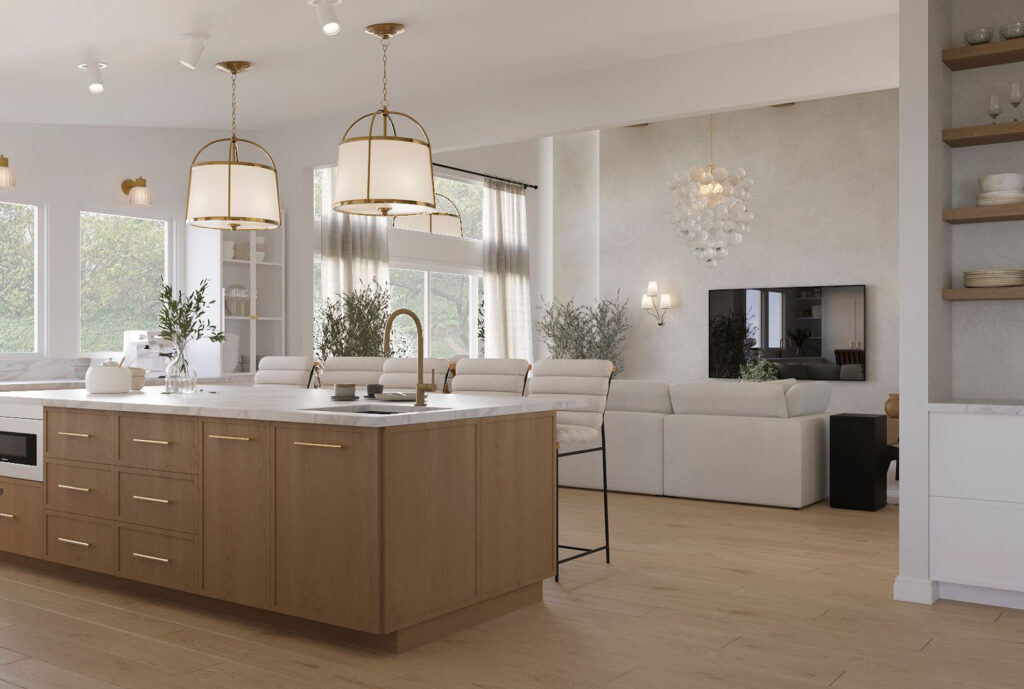
Exploring Examples
Organic modern interior design brings a sense of calm and connection to the natural world. It’s about blending sleek lines with organic shapes and textures. Let’s dive into some inspiring transformations, celebrity homes, and commercial spaces that showcase this style beautifully.
Before-and-after transformations in organic modern homes are truly striking. They often start with cluttered, dated interiors. Then, they transform into spaces where light flows freely, highlighting natural materials like wood and stone. Imagine a living room where dark walls become bright with eco-friendly paint. A heavy sofa is replaced by one made of sustainable materials. These changes not only improve aesthetics but also promote a healthier environment.
Celebrity homes can serve as a rich source of inspiration for organic modern design lovers. Take, for example, the home of an A-list actress known for her environmental activism. Her residence perfectly embodies this style through its use of reclaimed wood furniture and large windows that invite nature inside. Such examples illustrate how luxury and sustainability can coexist beautifully.
Commercial spaces adopting organic modern design principles show how versatile this style is beyond residential settings.
- Restaurants might feature bamboo floors,
- Offices could have living green walls, These elements create inviting atmospheres while emphasizing eco-friendliness.
Case studies from these commercial environments reveal increased customer satisfaction and employee well-being thanks to the serene ambiance provided by organic modern elements.
Diving into organic modern interior design, you’ve journeyed through understanding its essence, selecting furniture, playing with colors and textures, maximizing natural elements, and beyond. It’s not just about creating a space; it’s crafting your sanctuary that breathes life, simplicity, and elegance. Think of it as your canvas where each brushstroke of design choice paints the bigger picture of your ideal living space. It’s about harmony between nature and modernity, where less is more and every detail counts.
Now, it’s over to you. Armed with these insights, why not take the plunge? Start small, maybe with a corner of your home or a single room, and let your creativity flow. Share your journey, inspire others, and remember, the beauty of organic modern design lies in its ability to evolve with you. So go ahead, make your space a testament to who you are and what you love. Happy designing!
Frequently Asked Questions
What is organic modern interior design?
Organic modern design blends the sleek lines of modern decor with the warmth and natural elements of organic style. Think minimalism meets Mother Nature.
What are essential components in organic modern design?
Key ingredients include natural materials like wood and stone, neutral color palettes, clean lines, and plenty of light. It’s all about harmony between man-made and natural.
How do I select furniture for an organic modern space?
Choose pieces that speak to simplicity with a twist of nature—think a wooden coffee table or a sofa with clean lines upholstered in natural fabric.
Can you mix colors and textures in this style?
Absolutely! Mixing textures is crucial. Pair smooth surfaces with rough ones, like soft linen against raw wood. Stick to muted colors that mimic the outdoors for that serene vibe.
How can I maximize natural elements in my home?
Let the sunshine in through large windows or skylights. Incorporate plants, water features, or even use materials like bamboo flooring to bring the outside world into your living space.
What kind of decorative accents work best with organic modern design?
Opt for items that feel personal yet earthy—ceramic vases, woven baskets, or artwork depicting nature scenes fit perfectly without cluttering your zen oasis.
Any tips on maintaining the aesthetic over time?
Keep it simple; regularly declutter spaces to maintain those clean lines. Embrace changes in your environment by incorporating seasonal elements naturally found outside your door.
